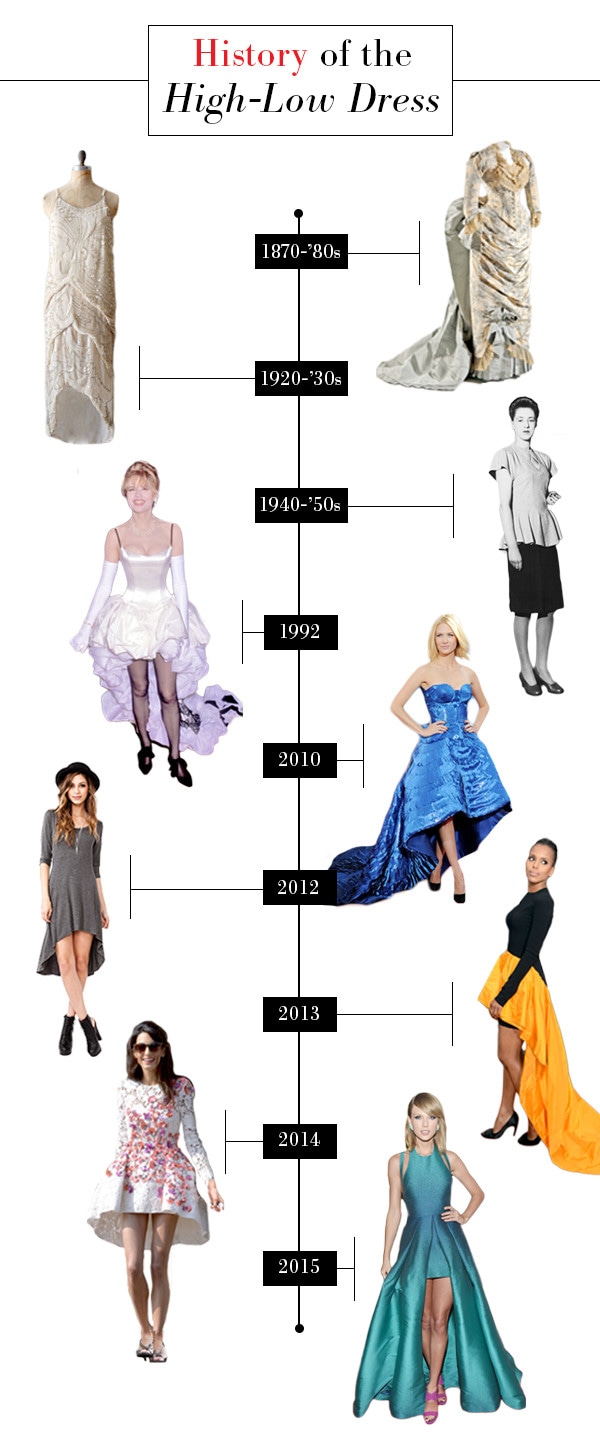 Kailey Strachan for E! Online
Kailey Strachan for E! OnlineThe mullet—you may know it as the ‘80s hairstyle turned divisive fashion trend.
The high-low hem, or waterfall skirt, is identified by one side ending at a higher point than the other. Many oppose it because of its non-proportional nature, but its appearance both on red carpets and in mass retail stores validates it as a true trend.
Given Taylor Swift's high-low Elie Saab stunner at the 2015 Grammys, we were wondering if the look will see a resurgence—or if it ever went away. Surprisingly, the evolution of the mullet is real.
1870s-1880s
The trend purportedly began in the Victorian era with formal dresses and gowns with "fishtail" hems. Many dresses would typically feature some kind of ruching or pleating, which would bunch up fabric and leave the top layer of the dress a tad higher than the lining or secondary layer. Fabric would also be added to the back to create more voluminous trains. The design created an illusion of curves—whether you had them or not.
Late 1920s-early 1930s
The Roaring ‘20s and early ‘30s were marked by glitz, glam and much shorter hemlines. It was the age of prohibition and rebellious sentiment, after all. The high-low hem was still prevalent on formal, albeit shorter, gowns—making it easier to get your Charleston on.
1940s-1950s
Post-World War II, clothing was much more functional, but it wasn't without its standout trends. Peplum detailing, which starts with a ruffled hem and jutes slightly out, was favored by both housewives and starlets. This trend birthed its modern-day iteration—asymmetrical peplum—which also features the same low-to-high design.
1992
Oh, Billy Ray Cyrus, you and your mullet gave "business in the front; party in the back" a whole new meaning. Little did you know that your asymmetrical haircut would be a full-fledged fashion trend come the new millennium. You also probably didn't know that Geena Davis would make Worst Dressed List history with her white Oscars dress.
2010
Sometime in the last five years, nostalgia became a thing, and we wanted to relive all the trends of our childhood memories. Betty Draper, err, January Jones was the ultimate throwback in a metallic-blue Versace dress. Unfortunately, fashion critics were not impressed.
2012
The fashion set's aversion to the high-low look did not stop fast-fashion brands from producing a slew of mullet dresses. Retailers like Forever21 and H&M made a fortune off the maxi-dress' easier-to-wear cousin.
2013
With both lovers and haters on each side of the fence, the high-low hem was pretty much ubiquitous by this point. However, fashion designers modernized the look, pairing layers with cleaner lines, like the color-blocked Michael Kors dress Kerry Washington wore to the MTV Movie Awards.
2014
High fashion designers also modernized the look by playing with proportions and subtlety. Michelle Dockery's 2014 Golden Globes dress featured an ever-so-slight high-low hem, which brought the sophistication of a tea-length dress. Not to mention, we got a better view of her shoes. Designers also incorporated a slight high-low hem on more casual, shorter pieces, like the Giambattista Valli Couture mini dress Amal Clooney wore right after wedding the Ocean's Eleven star.
2015
Tay-Tay in 2015 Elie Saab pretty much killed the Grammys red carpet. Swifty was on everyone's Best Dressed list—probably because her dress incorporated all the elevated elements of a high-low gown: clean lines, bold color and cutouts. It was basically a cape for her waist—and you know how much fashion people love their capes.
So, will this trend ever be fully accepted? Only time will tell.